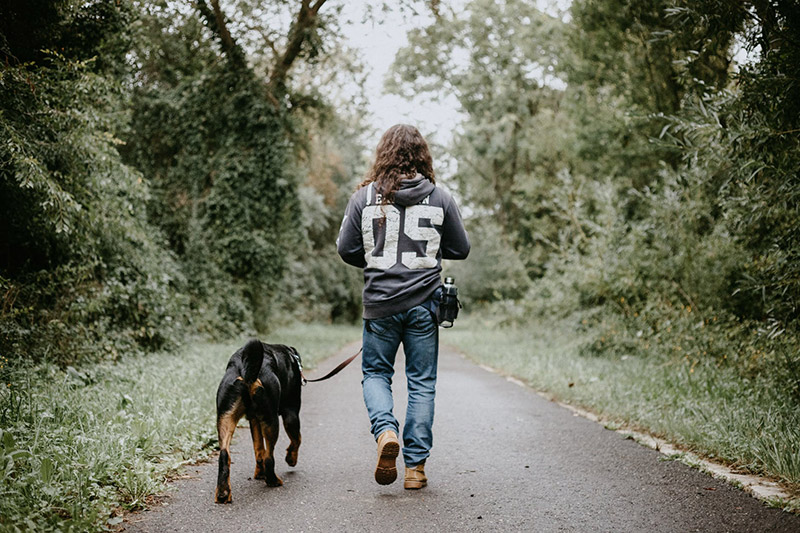(Aether Bios Clinic) Bridgeford’s Best Bites: Osteopathy Tips
DOG WALKING ISSUES – PROBLEMS FROM WALKING YOUR POOCH

Photo by Tom and Sini on Pexels.com
As a nation, we are animal lovers; we love our fur family and want to take good care of them. What about the impact on our bodies of an activity such as walking or beloved dogs? Some of the issues are year round, others are seasonal such as the terrain, the weather, the livestock and their young where we are walking. Many of my patients have injuries and aches and pains from issues around dog walking.
COMMON PHYSICAL ISSUES
Many of the physical issues from dog walking relate to slips, trips and falls; other common issues are from a dog pulling on the lead, lifting heavy dogs in and out of the car when they are no longer able to jump and also carrying an injured dog; even if the dog is small we are probably dealing with emotions that make the task trickier. Issues such as tennis or golfer’s elbow, rotator cuff and shoulder joint pain as well as forearm, wrist and hand pain can result from a dog pulling on the lead either suddenly or repeatedly, this can also pull up into the neck and back. Strained back or neck, sprained ankle and twisted knee can result from slips, trips and falls as well as awkward lifting and bending, e.g. to pick up a ball repeatedly.
WEATHER, SEASONS AND TERRAIN
Each season has it’s issues with dog walking. Icy or wet ground makes it more likely that you can slip, trip or fall. When the weather is cold you may be more likely to get muscle aches and pains and we are certainly all stiffer in the morning than in the evening anyway. When the weather is hot, we need to keep ourselves and our dogs well hydrated and may need to go out earlier to avoid the intense heat. Dry ground may have more loose stones that we can trip on. We need to be aware when there is low lying strong sunlight that it can blind drivers, making it more difficult to spot walkers at certain angles. It is also important to know your own and your dog’s limitations of distance and energy for a walk.
FOOTWEAR AND ATTIRE
Blisters can be a problem if your shoes do not fit well. It is also important to have appropriate shoes for the weather and terrain and often something with good support to help keep you steadier. Whilst wellies help keep you dry they do not always offer good support. If you have issues with over pronation or falling arches, a good foot support can help the alignment of many joints in the body by starting with good foot alignment. Of course weather appropriate clothes are important, rainwear in the wet as well as hats, sunglasses and sun cream in the heat.
KEEPING FIT FOR DOG WALKING
We need to be fit to walk our dogs like any other physical activity. Even though dog walking is itself an exercise, we need to keep ourselves strong, fit and supple to keep it going all year round. Strengthening and stretching exercises are important. The whole body can be affected by slips, trips and falls, a dog pulling on the lead, lack of upper back strength with a big dog on the lead, lifting large dogs, incorrect lifting, lack of core strength.
TIPS
Back, Neck and Shoulders: It is important to learn correct lifting technique to keep the back strong and also how to use your upper back muscles around the shoulder blade to have better strength and control in your arm and prevent the tension going to the low back, the neck or the arm from a lead pull. Good core strength is crucial for a healthy low back and in fact for the whole body biomechanics. Learn to stretch well.
Elbows, Forearms, Wrists and Hands: There are some good stretching exercises for forearms, wrists and hands to release tension and also build strength. Avoid gripping the lead too tight, try one that wraps around the wrist for extra control.
Hips, Knees, Ankles and Feet: Strength and flexibility are important for keeping active. Learn to stretch hip flexors, hamstrings, butt muscles, calves, feet and ankles. Wear appropriate footwear and orthotics if needed. Keep the thighs strong and avoid twisting the knee suddenly or repeatedly.
See related articles on my blog
Stumbles and falls, body compensation, repetitive strain injury, trapped nerves
Sprained ankle, plantar fasciitis, shin splints, knee pain, leg cramps, psoas muscle, piriformis syndrome, back pain, sciatica.
Tennis elbow, carpal tunnel syndrome, frozen shoulder.
We are happy to advise you on your health matters and happy to create exercise videos on Aether Bios YouTube channel.
Lin Bridgeford DO KFRP MICAK MICRA FSCCO MSc
Registered Osteopath & Kinesiologist & Senior Yoga Teacher
Aether Bios Clinic
Saltdean
01273 309557 07710 227038
www.osteo-info.co.uk www.biosyoga.co.uk
https://linbridgeford.wordpress.com contains all my articles as blogs
